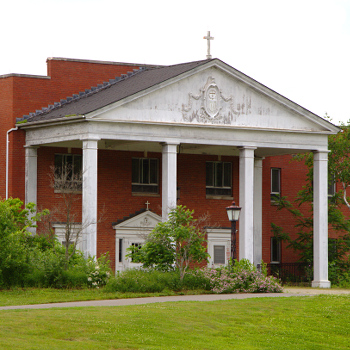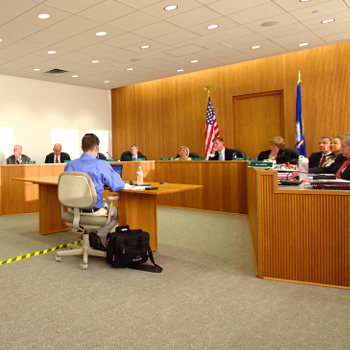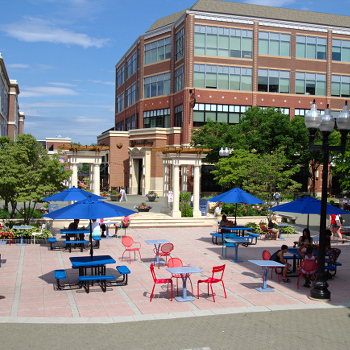West Hartford is a hot location for real estate development right now. There are numerous projects, large and small, that are either underway or on the drawing board.
 Here is a quick list off the top of my head, from the northern part of town to the southern part. An apartment conversion on Albany Avenue in Bishop’s Corner. A proposed apartment community on Steele Road. A proposed single-family home development on the American School for the Deaf campus. An expanded/updated office building on the corner of Brace and North Main. A proposed conversion of two single-family homes to an multi-family community at Farmington and Bishop Road. Redevelopment of the Masonic Temple building on South Main. A luxury hotel in Blue Back Square. An apartment community at the Sisters of St. Joseph campus at Park and Prospect. Four townhouses replacing a single-family home on the corner of Oakwood and Englewood. An apartment community on Newington Avenue. I’m sure there are others that I’m not remembering at the moment.
Here is a quick list off the top of my head, from the northern part of town to the southern part. An apartment conversion on Albany Avenue in Bishop’s Corner. A proposed apartment community on Steele Road. A proposed single-family home development on the American School for the Deaf campus. An expanded/updated office building on the corner of Brace and North Main. A proposed conversion of two single-family homes to an multi-family community at Farmington and Bishop Road. Redevelopment of the Masonic Temple building on South Main. A luxury hotel in Blue Back Square. An apartment community at the Sisters of St. Joseph campus at Park and Prospect. Four townhouses replacing a single-family home on the corner of Oakwood and Englewood. An apartment community on Newington Avenue. I’m sure there are others that I’m not remembering at the moment.
Developer interest means that the Town is doing something right. This is especially true when most (all?) of the projects are privately financed. West Hartford is an attractive location for development because of its strong reputation and central location in the region. The Town website prominently features a list of 11 instances in which West Hartford has been recognized and/or highly ranked. One would think that high rankings and developer interest is a good thing.
It turns out that developer interest is not universally seen as a positive. Amy and I attended some of the Public Hearing on the Steele Road proposal that was held on June 24th. We made it through the 3 hours of public comment, which was of most interest to us, but did not stick around for the rest of the session.
 The primary concern of residents regarding the Steele Road apartment proposal was the likelihood of increased traffic, and the increased traffic was almost always tied to safety concerns. Residents from the immediate vicinity of the project, and from surrounding streets, turned out to voice their concern. Most reported that traffic is already dangerous on their street, and that this project would only make it worse. Note that other concerns were also raised.
The primary concern of residents regarding the Steele Road apartment proposal was the likelihood of increased traffic, and the increased traffic was almost always tied to safety concerns. Residents from the immediate vicinity of the project, and from surrounding streets, turned out to voice their concern. Most reported that traffic is already dangerous on their street, and that this project would only make it worse. Note that other concerns were also raised.
The Steele Road proposal, like all of the others listed above, will increase the density of West Hartford. The projects will result in more people living in Town, and in the case of the office buildings on Main Street, more people working in Town. Some projects are larger than others, but each and every one of them is going to increase traffic. They will also provide revenue to the Town, through both permit fees in the near term and property taxes in the long term.
This presents an interesting dilemma, and by no means one that is unique to West Hartford or 2014. What is the Town’s leadership to do? Is additional development good or bad?
Residents adjacent to a proposed development tend to oppose the project since they will be the ones experiencing the negative impact in their immediate environment. West Hartford is mostly residential, ensuring that someone’s living situation will be impacted by just about every proposed project. What is the best way for Town leaders to deal with this reality?
Rejecting any project in which there are objections is not practical since there are always objections. Similarly, approving all projects is not prudent either since not all projects are a good idea. Developers shouldn’t control the evolution of the town and residents shouldn’t force it to remain static. There needs to be a balance between the status quo and new ideas; between the predictable objections of the immediate neighbors and the greater good of the community.
 In the case of the Steele Road proposal, it seems like the developer really, really, really wants to build on the site – so the Town and neighbors have leverage. Perhaps there is an opportunity for compromise. The Stratford Road residents have already negotiated a change to their street into the deal. The developer has agreed to pay to convert it from a through street to a dead end to prevent drivers from using it as a short-cut. The developer has also made meaningful concessions to the neighbors on Trumbull and Buckingham, offering a 40 foot green space buffer that includes the existing mature trees, an earthen berm of between 4 feet and 7 feet tall, and additional evergreen and deciduous trees planted on their side. The developer also offered to plant up to 10 trees in the adjacent homeowners’ back yards if they wanted them. The fundamental traffic concerns are unlikely to be completely resolved – 200 apartments (versus zero now) will necessarily result in more traffic.
In the case of the Steele Road proposal, it seems like the developer really, really, really wants to build on the site – so the Town and neighbors have leverage. Perhaps there is an opportunity for compromise. The Stratford Road residents have already negotiated a change to their street into the deal. The developer has agreed to pay to convert it from a through street to a dead end to prevent drivers from using it as a short-cut. The developer has also made meaningful concessions to the neighbors on Trumbull and Buckingham, offering a 40 foot green space buffer that includes the existing mature trees, an earthen berm of between 4 feet and 7 feet tall, and additional evergreen and deciduous trees planted on their side. The developer also offered to plant up to 10 trees in the adjacent homeowners’ back yards if they wanted them. The fundamental traffic concerns are unlikely to be completely resolved – 200 apartments (versus zero now) will necessarily result in more traffic.
West Hartford has experienced waves of development and redevelopment over the years. I believe that this evolution, the willingness to try new things, has been a key component in making West Hartford the desirable town that it is today. Blue Back Square, for example, was a controversial redevelopment idea in the early 2000s. It was larger than any of the current projects, and engaged citizens throughout town, but the public debate still featured many of the immediate neighbors sharing concerns about traffic. Ten years later, Blue Back Square seems to be a major attraction for West Hartford and a hotel is the works.
Town leaders have faced difficult decisions before and will continue to face them in the coming years. As UConn moves out of their campus on Asylum and Trout Brook, another large parcel of land will open up for redevelopment. The overall success of West Hartford attracts investment interest, which in turn creates changes and forces everyone to adapt to the new reality.
All the evidence I see points to West Hartford continuing to become more densely inhabited. Density will increase on the Steele Road site whether it becomes the 200 proposed apartments, or the 92 (approved) senior units from a 2008 proposal, or 30+ single-family homes on those 15 acres. The more interesting question is how the Town navigates the path towards higher density. It’s an important issue for leaders and residents to work through, and one that developers will be following closely.